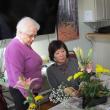Grey skies, bright blooms: The delicate composition of Ikebana
ROCKLAND — On a grey, Saturday morning in Rockland, the weather forecast calls for more snow during the weekend as adult students sit around a work table at the Penobscot Language School. Surrounded by bright bunches of baby’s breath, chrysanthemums and lilies, participants are contemplative as they try their hand at Ikebana, the ancient Japanese art of flower arrangement.
Sachiko Clough, a Penobscot Language School instructor, examines the arrangements from each student, providing guidance on how to place the height and the angles of the stems in shallow ceramic dishes. Originally from Osaka, Clough is a certified Japanese language teacher and also holds licenses in Ikebana and Japanese tea ceremony.
“In Japan, people learn how to do Ikebana all of their life,” she said. “You have to have at least two to three years to finally master it.”
Two of the most common Ikebana styles are called Heika, which are arranged in tall, thin vases and Moribana, which use low, shallow containers. In the first of two classes, Clough is teaching students how to create Moribana freestyle, a method of flower arrangement that is left completely up to the arranger on how to group the flowers. With this technique, the focal point of the composition depends on the arranger’s own sense of proportion and harmony.
However, even in Moribana freestyle there are certain rules. “You want the stems to be different heights and to form an asymmetrical triangle,” said Clough. The students all attempt to find that imaginary triangle as they study each of the blossoms before them and work to arrange the stems into a “flower frog,” a spiky tool at the bottom of the shallow dish, that can hold the trickiest of flower arrangements, even the thinnest stems as they stand upright or at projected angles.
Clough’s next class the following Saturday will once again encompass more layers to Moribana freestyle, but with different fresh flowers. Clough said given the time frame, it would be impossible to introduce a different Ikebana style to the students as it would take weeks and weeks to learn.
Liga Jahnke, a student who has participated in Clough’s previous Ikebana classes, continues to hone her skills with each new class. “I often try Ikebana at home, using flowers from my garden, annuals and perennials which are in season,” she said. “I also use wildflowers—anything that celebrates the seasons. I don’t consciously try to make a particular color scheme; I just use nature’s palate.”
The process of carefully looking at each stem and and finding the best line to position it is meditative—entirely the point of Ikebana. While it may be cold and dreary outside, the practice of working with fresh blooms and branches brings nature inside for awhile—and in the moment, spring has arrived.
For more information visit: What is Ikebana?
For more info Penobscot Language School visit: penobscot.us
Kay Stephens can be reached at news@penbaypilot.com
Event Date
Address
United States




























